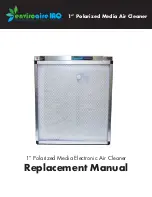
10
1. Set the thermostat to above room temperature.
2. Verify that the compressor and outdoor fan motor are
not energized and the electric heat is energized.
3. After the unit has run for approximately five minutes,
set the thermostat below room temperature and verify
that the electric heat has de-energized.
WARNING:
Uninsulated live components are exposed when
control access panel is removed.
Verify Operation of Over-Temperature Limit Control
To verify operation of the over-temperature limit control,
make sure that all access panels are in place and that
there is power to the unit. Block the return airflow to the
unit by installing a close-off plate in place of or upstream
of the filter. Set the thermostat to a temperature above
room temperature and verify the unit operates with the
correct operating sequence (see Operating Sequence).
The over-temperature limit control should function to turn
off the electric strip heat within approximately four minutes
NOTE:
the exact time depending on the efficiency of the
close-off in blocking the return air to the unit.
The circulating air blower should continue to run when
the over-temperature limit control switch opens. Remove
the close-off immediately after the over-temperature limit
control opens. If the unit operates for more than four minutes
with no return air, set the thermostat to a temperature
below room temperature, shut off the power to the unit,
and replace the over-temperature limit control.
OPERATING SEQUENCE
The operating sequences for the heating, cooling, and fan
modes are described below. Refer to the wiring diagrams
for the unit. See pages 21 - 22
Cooling mode
1. On a call for cooling the thermostat closes, applying
24 Vac to
Y1
,
G
, and
Y2
if stage 2 cooling is required.
2.
G
applies 24VAC to the main circulating blower circuit.
3.
Y1
and
Y2
apply 24VAC through all safety switches
Before energizing their respective contactors.
4. When the thermostat is satisfied the contactors are
De-energized.
5. The circulating blower motor is de-energized
Immediately.
Blower mode
1. On a call for fan operation, the thermostat applies 24
Vac directly to the blower contactor.
2. The circulating blower is energized immediately.
Heating mode
1. On a call for heat the thermostat closes, applying 24
Vac to the
W1
terminal.
Unit Fails to Operate
If the unit does not operate properly in either the heating
or cooling mode, be certain to check the following:
1. The thermostat is operating properly.
UNIT MAINTENANCE
WARNING:
To avoid risk of electrical shock, personal
injury, or death, disconnect all electrical power
to the unit before performing any maintenance
or service. The unit may have more than one
electrical supply.
CAUTION:
Use care when removing parts from this unit.
Personal injury can result from sharp metal
edges present in all equipment of sheet metal
construction.
CAUTION:
Verify proper operation after servicing.
Refrigerant Charging
Packaged electric units are fully charged at the factory.
The system refrigerant charge can be checked and
adjusted through the service ports provided behind the
compressor service panel. Use only gauge lines which
have a “Schrader” depression device present to actuate
the valve. Draw a vacuum on gauge lines to remove
air or moisture before attaching them to the service
ports on the unit. Refrigerant charging must be done by
qualified personnel familiar with safe and environmentally
responsible refrigerant handling procedures. See Unit
Rating Plate for proper amount of charge. See page 30.
WARNING:
The units are shipped fully charged and ready
for installation. When a system is installed
according to these instructions, no refrigerant
charging is required. If repairs make it necessary
for evacuation and charging, it should only be
done by qualified, trained personnel thoroughly
familiar with this equipment. Some local codes
require licensed installation/service personnel
to service this type of equipment. Under no
circumstances should the owner attempt to
install and/or service this equipment. Failure
to comply with this warning could result in
property damage, personal injury, or death.
2. Electrical power to the unit is turned on.
3. All safety switches are closed.
4. The service doors are in place.
5. Transformer circuit breaker is reset.











































